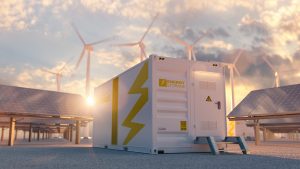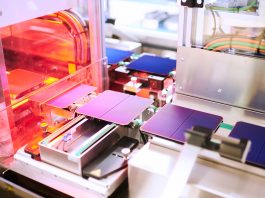Scott Parent, VP, Field CTO Energy, Aerospace and Industrials at Ansys, discusses how engineers can use optical simulation to maximise the benefits of solar power.
If the global effort to be net zero by 2050 is to be successful, every tool at our disposal will have to be explored. Renewable energy sources are a major focus area for organisations all over the world, and much effort is being made to develop these as we attempt to transition away from our reliance on fossil fuels.
Of these options, solar power is being touted as playing a particularly significant role, even becoming dominant by 2050, as it is cheap to implement and can generate electricity from anywhere on the globe and in any climate.
However, if solar energy is to fulfil its potential as a robust and reliable source of energy globally, there are two critical developments that have to occur. First is an exponential increase in solar power adoption, and the other is rapid advancements in the generation and storage technology currently on hand. Without these two critical improvements, solar energy will struggle to effectively contribute to the solution, putting a significant dent in our net-zero ambitions.
There are technologies that are currently being developed by companies, such as Australian-based renewable energy company RayGen, that aim to solve these issues, but due to their complexity, traditional methods of production could be far too costly and time-consuming.
This is where engineering simulation will play a pivotal role. Simulation allows firms like RayGen to consider and model every aspect of development – such as the movement of the sun or how individual components will react to a given set of circumstances – before being made, which drastically improves accuracy but crucially reduces cost and time-to-market.
Solar energy is stuck in the shadows
The common criticism of solar power that ‘it only works when the sun is shining’ may seem overly simplistic, but the reality is that there is some truth to this.
The issue of what to do when the Sun sets or when the weather limits its exposure remains the central issue. This requires solutions to be developed that not only maximise the efficiency and effectiveness of the solar energy that can be produced but also how to then store that energy once you have it.
Without a sufficient amount of energy being stored, grids are prone to becoming overloaded during the day when the Sun is at its peak, meaning that many have to hold back their solar generation.
Consequently, when the Sun is not available, power companies have to fall back on more traditional generation methods of generating power. This means that there is a lack of sufficient solar power for use in the evening, when energy use peaks, resulting in a reluctance to adopt solar energy on a wide scale. This is where an improved approach to solar power is needed in order to develop a solution that can ensure that grids are supplied with energy day or night or in any weather condition.
RayGen has developed a solar power plant in Victoria, Australia, that looks to combine both of these elements in what it calls the world’s largest long-duration energy storage project. This combines innovative ways to both produce and store solar energy and has employed the extensive use of simulation to overcome solar energy’s inherent obstacles.
Maximising the power of the Sun
First is the issue of capturing the maximum possible amount of solar energy in the first place. The Sun’s rays do not hit the earth in a consistent way, differing in angle and intensity depending on the time of day or different stages of the year.
As a result, engineers must develop ‘mirrors’, known as heliostats, that track the sun in the most effective way possible to concentrate its energy on the receivers that will generate the electricity. These heliostat fields are all calibrated differently depending on a range of conditions, and thus, designing each one to maximise efficiency is a monumentally complicated task, which, if done using traditional methods, would take a prohibitively large amount of time.
This is where optical simulation comes in. Engineers can use optical simulation to run countless simulations that judge the size, spacing, and curvature of the heliostats as well as the distance from the receiver and the angle of each individual mirror. This helps with the initial calculations, which saves significant amounts of time and money, but also reduces the need for engineers to produce costly and wasteful physical prototypes.
Additionally, structural simulation can be used to ensure that these heliostats are robust and able to work all year round and in changing conditions but with the least amount of material possible. If these heliostats are to be adopted all over the globe, it is crucial that they are as economical as possible, and this is where simulation will also play a crucial role.
Storing power for a rainy day

Once you have maximised the way to generate solar power, an effective way to store it must be developed.
Currently, businesses are able to capture and store solar energy through the use of large, expensive and inefficient batteries. Although not ideal, for smaller-scale operations, these batteries can suffice.
However, for large operations, such as grid-connected solar farms, the lack of low-cost storage has been a major issue and one that RayGen has attempted to solve.
To do this, it has turned to an established way to store energy – pit thermal energy storage. This involves using energy to heat up large bodies of water, which are able to store thermal energy for weeks or months at a time. It is an established technique in countries like Denmark, which heat up these bodies of water in the summer and distribute the hot water to people’s homes during the winter. The losses in energy are extremely low, with as little as 5 or 10% of thermal energy being lost over a period of six months or so.
However, the process is complicated, involving a delicate balance between heating and cooling to ensure that energy is stored in the most efficient way possible. RayGen turns to simulation again to help with this process. By using computational fluid dynamics, RayGen can model the water flow to ensure that the water is kept at an acceptable operating temperature and is diffused in a uniform and low-velocity way, meaning that hot and cold water don’t mix – a crucial part of the process.
If solar energy is to achieve its potential, continued improvements in techniques, processes, and infrastructure will be needed.
Without simulation, this process may not be attainable. Unless these advances in technology are economically viable, their benefits may never be realised. Simulation’s ability to help engineers maximise solar power solutions in a cost-effective and timely manner could prove to be crucial as we look to a net zero future.









